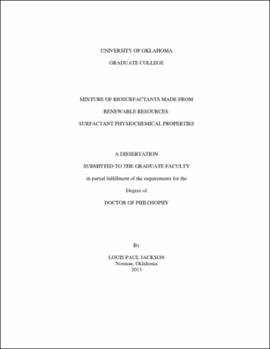| dc.contributor.advisor | Grady, Brian P||Nollert, Matthias | |
| dc.creator | Jackson, Louis Paul | |
| dc.date.accessioned | 2019-04-27T21:37:40Z | |
| dc.date.available | 2019-04-27T21:37:40Z | |
| dc.date.issued | 2013 | |
| dc.identifier | 99356025602042 | |
| dc.identifier.uri | https://hdl.handle.net/11244/319196 | |
| dc.description.abstract | Complete removal and substitution of non-renewable with renewable surfactants in consumer products is often not possible without the reduction of desirable properties (solubility, wetting, detergency, etc.). The synergetic relationship in mixtures might prove advantageous in reducing the environmental footprint and increasing the biocompatibility of consumer products that use surfactants. Binary aqueous mixtures of (1) alkyl glucopyranosides (glycosides), (2) alkyl maltopyranosides (maltosides), or (3) alkyl N-methyl glucamines with (1') sodium alkyl sulfates or (2') sodium n-alkyl carboxylates were investigated in an effort to evaluate physiochemical properties for mixtures of surfactants from renewable resources. Through surface tension and nuclear magnetic resonance (NMR) experiments solutions at various concentrations and mixture ratios were evaluated to determine critical micelle concentrations (CMCs). The greatest reduction in CMC was found for surfactants with long and intermediate hydrophobe lengths. In agreement with other studies, an increase in hydrophilic group size and flexibility decreased the electrostatic repulsion of ionic-nonionic mixed micelles as evidenced by a more negative Rubingh's â parameter. However, at low hydrophobe length, carboxylate and glycoside headgroup mixtures produced mixed micelle interactions displaying synergism at low nonionic surfactant mole fractions and slight antagonism at high nonionic mole fractions. The asymmetry in interaction produces an S-shaped CMC curve and demonstrates that the one-parameter Rubingh model is insufficient in describing both synergism and antagonism for this binary mixture. The analysis of NMR data revealed a stepwise mechanism of micelle formation for 1:9 sodium sodium alkyl sulfates and alkyl glucopyranosides mixtures. | |
| dc.description.abstract | In addition, aqueous solutions of sodium n-alkyl carboxylates sodium tetradecanoate (S14C) and sodium dodecanoate (S12C) were used to evaluate complicated precipitation zones and to monitor the effects of bulk pH adjustments on surface tension and CMC determination from surface tension plots. Issues with solubilities of pure sodium n-alkyl carboxylates in solution near the critical micelle concentration (CMC) have been reported previously many times. In this study, some solubility issues encountered with solutions prepared from vendor-supplied S12C were resolved through additional purification. As sodium alkyl carboxylates presented in the literature are commonly used as received from the manufacture without additional purification, the wide range of reported CMC values as well as solubility issues for S12C are likely due to impurities as well. However, solubility for S14C solution concentrations near reported CMC values were not resolved through additional purification of purchased material. We believe that CMC values reported in the literature for C14S should be reconsidered, as breaks in surface tension relationships are likely caused by the formation of precipitate not micelle aggregation. In addition and in agreement with other studies, solution pH adjustments revealed an optimum surface tension for maximum solubility near S14C pKa values. | |
| dc.format.extent | 87 pages | |
| dc.format.medium | application.pdf | |
| dc.language | en_US | |
| dc.relation.requires | Adobe Acrobat Reader | |
| dc.subject | Surface active agents | |
| dc.subject | Green chemistry | |
| dc.title | MIXTURE OF BIOSURFACTANTS MADE FROM RENEWABLE RESOURCES: SURFACTANT PHYSIOCHEMICAL PROPERTIES | |
| dc.type | text | |
| dc.type | document | |
| dc.thesis.degree | Ph.D. | |
| ou.group | College of Engineering::Department of Bioengineering | |
